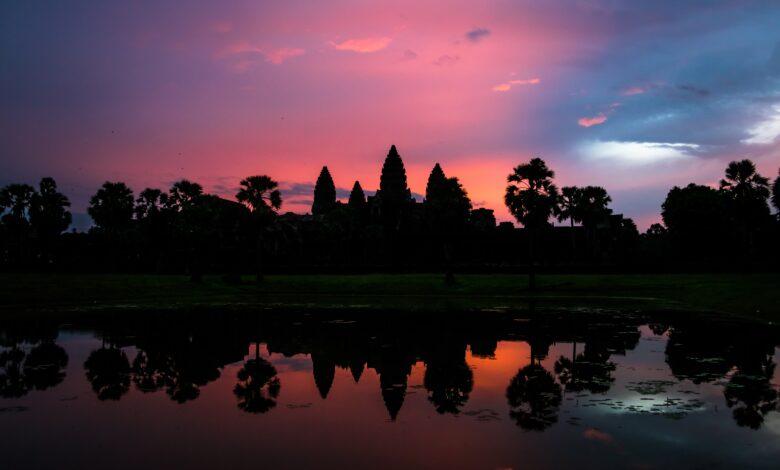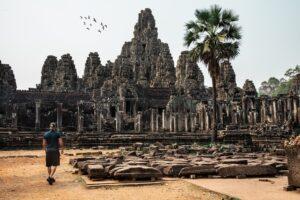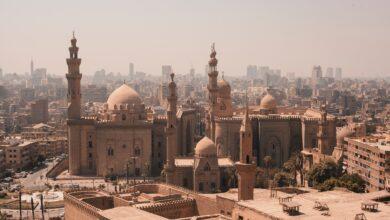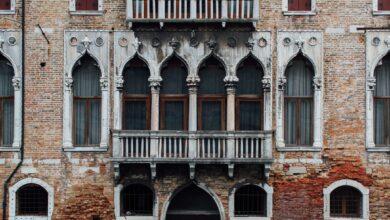Exploring the Temples of Angkor Wat, Cambodia 🏯
Journey Through Ancient Mysteries and Architectural Marvels

Introduction
In the heart of Cambodia, amidst a sprawling jungle of emerald green, lies a treasure trove of ancient wonders—the temples of Angkor Wat. These magnificent structures have been shrouded in mystique and fascination for centuries, drawing travelers from all corners of the globe. Angkor Wat’s grandeur transcends mere stone and mortar; it is a testament to the ingenuity, artistry, and spiritual devotion of the Khmer people. In this blog post, we invite you to embark on an expedition through the enchanting temples of Angkor Wat, Cambodia. Beyond the legendary Angkor Wat itself, we will unveil the enigmatic faces of Bayon, the captivating embrace of Ta Prohm by nature, the exquisite beauty of Banteay Srei, and the hidden gems concealed deep in the Cambodian jungle. So, don your adventurer’s hat, and let’s journey through time and space to explore the remarkable temples of Angkor Wat.
The Magnificence of Angkor Wat
Angkor Wat’s Architecture and Layout
Nestled amidst the lush Cambodian jungles, Angkor Wat stands as an architectural masterpiece, captivating visitors with its breathtaking grandeur. This ancient temple complex, originally built in the 12th century, boasts a unique blend of Khmer temple and pyramid architecture, making it one of the most remarkable religious monuments in the world. When crafting an SEO-optimized article, it’s essential to emphasize the distinct architectural features of Angkor Wat.
The temple’s central tower, representing Mount Meru, the mythical abode of the gods, soars to a height of 213 feet, while its five iconic lotus-bud towers surround it, forming a quincunx pattern. The vast courtyards, galleries, and intricate colonnades showcase the precision and ingenuity of Khmer engineering. These details draw millions of tourists each year, eager to witness this architectural marvel up close.
The Intricate Bas-Reliefs that Depict Historical and Mythological Narratives
One of Angkor Wat’s most enchanting aspects is its extensive collection of bas-reliefs, etched onto the temple’s walls. These intricate carvings serve as a visual library of historical and mythological narratives, providing invaluable insights into the Khmer Empire’s rich heritage. When optimizing your article for SEO, it’s crucial to highlight the significance of these bas-reliefs, which are a treasure trove of cultural and historical knowledge.
The bas-reliefs cover a staggering 600 meters of wall space and narrate tales from Hindu epics like the Ramayana and Mahabharata. They also depict scenes from Khmer history, including battle sequences and daily life. Such depictions not only fascinate art enthusiasts but also historians and archaeologists. It’s this fusion of art and history that makes Angkor Wat a UNESCO World Heritage Site and a must-visit destination for travelers.
Sunrise at Angkor Wat and Its Iconic Reflection
Among the most iconic experiences at Angkor Wat is witnessing the sunrise over the temple’s majestic silhouette, with its reflection cast upon the tranquil waters of the surrounding moat. This enchanting spectacle attracts early risers from all corners of the globe and is a prime focus for SEO-optimized articles about Angkor Wat.
Arriving in the pre-dawn darkness, visitors gather at the temple’s western causeway to catch the first rays of sunlight as they bathe the temple in a warm, golden glow. The serenity of the moment and the captivating beauty of the reflection in the moat make it a prime spot for photographers. For those seeking a spiritual experience, it’s an ideal time for quiet contemplation amidst this ancient wonder.
The Enigmatic Bayon Temple
The Mesmerizing Stone Faces of Bayon
The Bayon Temple, located within the sprawling Angkor Thom complex in Cambodia, is renowned for its enigmatic and captivating stone faces that have left visitors in awe for centuries. As you craft an SEO-optimized article about this remarkable temple, be sure to spotlight the iconic stone faces of Bayon that have intrigued explorers and scholars alike.
The most striking feature of Bayon is the multitude of massive stone faces adorning its towers. There are 54 towers, each adorned with four serene, smiling visages, amounting to a staggering total of 216 faces. These enigmatic faces are believed to represent Bodhisattva Avalokiteshvara or perhaps the deity King Jayavarman VII, who ordered the temple’s construction.
These captivating stone carvings have attracted visitors from around the world. The intricate detailing and the sense of mystery surrounding their meaning make them a prime focus for photographers and history enthusiasts alike.

Exploring the Labyrinthine Corridors and Galleries
One of the most intriguing aspects of Bayon is its complex and labyrinthine layout. When creating an SEO-optimized article, it’s important to emphasize the adventure of navigating through the temple’s intricate corridors and galleries.
Bayon’s interior is a maze of narrow passageways, steep staircases, and hidden chambers, waiting to be discovered. The temple’s multiple levels and interconnected galleries offer a sense of exploration and excitement, making it a paradise for archaeology and adventure seekers.
As you wander through the cool, dimly lit passages, you’ll encounter bas-reliefs depicting daily life, religious ceremonies, and historical events. This offers a fascinating glimpse into the Khmer Empire’s culture and history.
The Temple’s Role in Khmer History
To complete your SEO-optimized article, it’s essential to delve into the historical significance of Bayon Temple in Khmer history. The temple played a pivotal role in the grand tapestry of the Khmer Empire, and this should be highlighted.
Built in the late 12th century by King Jayavarman VII, Bayon served as the state temple of the capital city of Angkor Thom. It was originally dedicated to Mahayana Buddhism but later transformed into a Hindu temple as religious beliefs evolved.
The temple’s strategic location within the ancient capital speaks to its political and spiritual importance, as it stood at the heart of an empire that thrived for centuries. This historical context adds depth and significance to the Bayon Temple, making it not only a marvel of architecture but a symbol of Khmer power and culture.
Ta Prohm: Nature’s Reclamation
The Temple’s Fusion with the Jungle
Ta Prohm, a temple nestled within the sprawling Angkor Archaeological Park in Cambodia, is a captivating testament to the inexorable force of nature. When crafting an SEO-optimized article about this ancient temple, it’s essential to highlight the remarkable fusion between the temple and the encroaching jungle.
What sets Ta Prohm apart from other Angkor temples is its entwinement with the surrounding forest. Massive silk-cotton and strangler fig trees have grown over, around, and through the temple’s stone structures. Their gnarled roots and branches create a mesmerizing, harmonious clash between human architecture and nature’s relentless reclamation. This fusion makes Ta Prohm a photographer’s dream, with its striking visual contrasts and the surreal sense of time standing still.
The Iconic “Tomb Raider” Tree
One of the most iconic features of Ta Prohm is the massive tree famously known as the “Tomb Raider” tree. This tree has become a symbol of the temple, thanks to its prominent appearance in the Hollywood film “Lara Croft: Tomb Raider.” To create an SEO-optimized article that resonates with readers, it’s crucial to spotlight the allure of this remarkable tree.
The “Tomb Raider” tree, a silk-cotton tree with colossal roots and branches, stands sentinel over the temple’s central sanctuary. Its roots wind their way through the stone structure, creating a surreal, yet beautiful, scene that captures the imagination of visitors. The juxtaposition of the ancient temple ruins and the majestic tree creates a sense of wonder, making it a must-see attraction at Ta Prohm.
The Ongoing Conservation Efforts
While Ta Prohm’s embrace by nature is awe-inspiring, it also poses significant conservation challenges. To complete your SEO-optimized article, it’s essential to discuss the ongoing efforts to preserve this unique and fragile site.
Conservationists and archaeologists have been working tirelessly to protect Ta Prohm’s structural integrity while maintaining its harmonious coexistence with the jungle. The delicate balance between preservation and allowing nature to flourish is a subject of great importance. Visitors to Ta Prohm are often asked to respect the guidelines and stay on designated paths to minimize human impact.
Efforts to safeguard Ta Prohm are crucial, as it ensures that future generations can continue to experience this mesmerizing blend of history and nature. By raising awareness about the ongoing conservation work, your article can contribute to the responsible and sustainable tourism of this extraordinary site.
Banteay Srei: The Citadel of Women
The Temple’s Exquisite Pink Sandstone Carvings
Banteay Srei, often referred to as the “Citadel of Women,” is a remarkable gem within the Angkor Archaeological Park in Cambodia. It’s celebrated for its exceptional pink sandstone carvings, which are considered some of the most exquisite and intricate in the Khmer temple complex. In an SEO-optimized article about Banteay Srei, it’s crucial to emphasize the magnificence of these carvings.
The temple’s carvings are a testament to the artistry and craftsmanship of the Khmer Empire. The delicate and highly detailed reliefs on the reddish-pink sandstone depict scenes from Hindu mythology, epic tales, and various deities. These carvings stand out not only for their intricate beauty but also for their relatively small size, requiring a level of precision that is truly awe-inspiring.
Visitors to Banteay Srei are often mesmerized by the stories these carvings tell and the meticulous attention to detail. The color of the stone further adds to the uniqueness of this temple, creating a visual feast that beckons tourists, photographers, and history enthusiasts alike.
The Stories Behind Its Name
Banteay Srei’s intriguing moniker, the “Citadel of Women,” adds a layer of mystique to this already enchanting temple. When creating an SEO-optimized article, it’s essential to delve into the stories and legends behind the temple’s name.
The name “Citadel of Women” is said to derive from the belief that the delicate and intricate carvings at Banteay Srei were so fine that they could only have been created by the dainty hands of women. While this story may be more myth than historical fact, it adds an element of romance and fascination to the temple’s identity.
Another tale connects the name to the notion that the temple was dedicated to a local goddess, suggesting a female presence in its history. These stories, though shrouded in the mists of time, contribute to the aura of mystery that surrounds Banteay Srei.
The Remote Charm of Banteay Srei
What sets Banteay Srei apart from other Angkor temples is its remote location, nestled amidst the Cambodian countryside. To make your article SEO-optimized and engaging, it’s important to highlight the serene and secluded charm that the temple exudes.
Compared to the more popular temples within the Angkor complex, Banteay Srei offers a quieter, more intimate experience. The temple’s location, some distance from the main Angkor area, results in fewer crowds, allowing visitors to explore its beauty at their own pace.
The surrounding landscape, with its lush greenery and rustic atmosphere, further enhances the temple’s charm. This makes Banteay Srei an ideal destination for those seeking a tranquil, off-the-beaten-path experience while exploring Cambodia’s rich historical heritage.
The Hidden Temples of Angkor
Koh Ker: A Pyramid Temple in the Jungle
Nestled in the heart of Cambodia’s lush jungles, the ancient temple complex of Koh Ker stands as a hidden gem within the expansive Angkor Archaeological Park. When crafting an SEO-optimized article about the lesser-known temples of Angkor, it’s essential to shine a spotlight on Koh Ker and its unique features.
Koh Ker is renowned for its towering pyramid temple, Prasat Thom, which soars to an impressive 98 feet, making it one of the tallest structures in the region. The temple’s remote location and relatively low tourist traffic lend it an air of untouched grandeur. Visitors who venture to Koh Ker are rewarded with awe-inspiring vistas of the Cambodian wilderness and an incredible sense of discovery.
The temple’s intricate stone carvings and serene, ancient statues are a testament to the artistry and craftsmanship of the Khmer Empire, making it a prime destination for history enthusiasts, adventure seekers, and photographers alike. Koh Ker’s enigmatic charm invites exploration and promises a truly unique experience.
Preah Khan: A Temple of Great Significance
While the grandeur of Angkor Wat and the beauty of Bayon often steal the limelight, Preah Khan stands quietly as a temple of profound historical and spiritual significance. In an SEO-optimized article, it’s important to delve into the rich history and unique attributes of Preah Khan.
Built during the reign of King Jayavarman VII in the late 12th century, Preah Khan served as a Buddhist monastery and a place of learning. The temple complex is not only an architectural marvel but also a symbol of the Khmer Empire’s dedication to Buddhism.
The temple’s labyrinthine layout, stunning bas-reliefs, and the unique Hall of Dancers all contribute to its appeal. Preah Khan is also known for its role in a restoration project that aimed to preserve its beauty and cultural heritage.
Visitors to Preah Khan will find a tranquil and reflective atmosphere, making it an ideal location for those seeking a deeper connection with Cambodia’s history and spiritual traditions.
Beng Mealea: A Remote and Untouched Gem
For travelers who long to escape the crowds and immerse themselves in the beauty of untouched archaeological wonders, Beng Mealea is a hidden treasure within the Angkor complex. When writing an SEO-optimized article about the hidden temples of Angkor, Beng Mealea’s remote and untouched allure must take center stage.
Beng Mealea is often described as an Indiana Jones-style adventure. Its remote location and the dense jungle that surrounds it create a sense of exploration and discovery. The temple’s dilapidated state, with trees growing through the stone structures, adds to its enigmatic charm.
What makes Beng Mealea truly special is its lack of restoration. Unlike many of its counterparts, it remains in its natural, unrestored state, allowing visitors to experience the authentic allure of an ancient temple engulfed by nature.
The temple’s sprawling layout, hidden courtyards, and intricate carvings tell the story of a bygone era. Visitors who venture to Beng Mealea are treated to an unforgettable journey into the heart of Cambodia’s history, making it a must-visit destination for adventurers and history buffs alike.
Practical Tips for Your Angkor Wat Adventure
Best Times to Visit Angkor Wat
When embarking on your Angkor Wat adventure, timing is crucial. To create an SEO-optimized article that helps travelers plan their visit, it’s essential to provide guidance on the best times to explore this remarkable archaeological wonder.
The ideal time to visit Angkor Wat is during the dry season, which typically spans from November to April. During this period, the weather is relatively cool and rain-free, ensuring comfortable sightseeing conditions. The months of December to February are particularly popular, as the temperatures are milder.
To avoid the sweltering heat and heavy crowds, consider visiting Angkor Wat early in the morning or later in the afternoon. Sunrise and sunset are magical times to witness the temple’s beauty, and they offer excellent lighting conditions for photography.
Purchasing Passes and Tour Options
One of the first steps in your Angkor Wat adventure is acquiring the necessary passes. An SEO-optimized article should provide practical advice on this process to assist travelers in obtaining their access permits and exploring the temple complex hassle-free.
Passes to Angkor Wat can be purchased at the Angkor Archaeological Park Ticket Center. Several options are available, including one-day, three-day, and seven-day passes. When selecting your pass, consider the duration of your stay and your interest in exploring the various temples within the park. Keep your pass with you at all times, as you will be required to show it at temple entrances.
While exploring Angkor Wat is possible independently, guided tours are also widely available. These tours provide valuable insights into the temple’s history and significance. Travelers can choose from a variety of tour options, including group tours, private tours, and even specialized photography tours to capture the temple’s beauty.
Dress Code and Respectful Tourism Practices
To ensure a respectful and meaningful experience at Angkor Wat, it’s essential to adhere to the dress code and follow responsible tourism practices. In an SEO-optimized article, you should emphasize the importance of respectful behavior while visiting this sacred site.
Angkor Wat is an active place of worship, and visitors should dress modestly. Both men and women are required to cover their shoulders and knees when entering temple grounds. Wearing comfortable, breathable clothing is essential, especially during the hot season.
Respectful tourism practices include refraining from climbing on temple structures, touching carvings, or defacing the site in any way. It’s vital to listen to your guides and follow their instructions. Be mindful of other visitors and the serene atmosphere of the temples, refraining from loud conversations and excessive noise.
FAQs
Q. How do I get to Angkor Wat?
A. Siem Reap International Airport is the closest airport to Angkor Wat. From there, you can take a tuk-tuk or taxi to the temple complex.
Q. Is there an entrance fee to Angkor Wat?
A. Yes, there is an entrance fee to Angkor Wat. Prices vary depending on the duration of your visit, with options for one, three, or seven days.
Q. What should I wear when visiting Angkor Wat?
A. It’s important to dress modestly when visiting the temples. Both men and women should wear clothing that covers their shoulders and knees.
Q. Are guided tours available at Angkor Wat?
A. Yes, guided tours are readily available at Angkor Wat. A knowledgeable guide can provide valuable insights into the history and significance of the temples.
Q. What is the best time to visit Angkor Wat?
A. The best time to visit Angkor Wat is during the dry season, from November to March, when the weather is pleasant, and there is less chance of rain.
Q. Are there accommodations near Angkor Wat?
A. Yes, there are numerous hotels and guesthouses in Siem Reap, the gateway to Angkor Wat, offering a range of accommodations to suit various budgets.
Conclusion
As we bid adieu to the captivating temples of Angkor Wat, we hope this virtual expedition has ignited your wanderlust and curiosity. The ancient Khmer civilization’s legacy endures in these exquisite temples, each with its own story to tell. We encourage you to consider a visit to Angkor Wat and its surrounding temples in person, for no words or images can capture the awe-inspiring ambiance that fills the air amid these ancient stones. May you find yourself immersed in the history, art, and spirituality that define Angkor Wat, and may you, too, be inspired by the resilience of these timeless treasures, where history whispers and stones speak. So, as you step away from the enchantment of Angkor Wat, remember that the temples await your discovery, promising a journey of wonder and amazement. Farewell, and may your own Angkor Wat adventure be filled with awe and wonder.
Related post
Paris Beyond the Eiffel Tower: Hidden Gems in the City of Light ✨




Facebook Comments